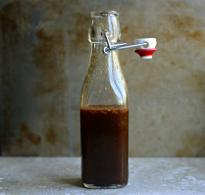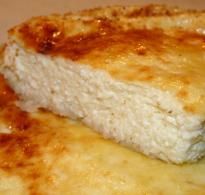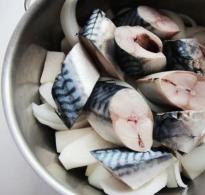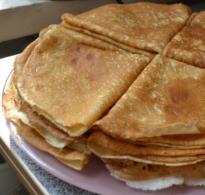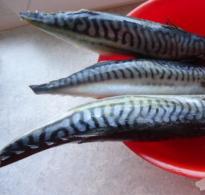An oven for making Georgian bread. Watching the work of mtskhobeli or how tonis puri (bread in the tone oven) is baked in Georgia
Georgians say: "Kveli yes puri - ketili ghuli". Which translates as: "Cheese and bread - yes a good heart." I already wrote that in Georgia it means an invitation "for coffee". In most cases, after such an invitation, we were treated to everything that was in the house - mchadi, khachapuri, tkemali, badridjans in nut sauce, satsiva, bage sauce ... The meal was accompanied by a tasting of delicious homemade wine, numerous toasts, sincere conversations. And if the "set for coffee" changed from house to house, then such components as cheese and bread remained unchanged. Bread and cheese were always on the table. And we were always met by people with a kind open heart.
And we have more than once observed how bread is baked in Georgia, because almost every family prepares its own soft fragrant bread. Sometimes bread is baked in an oven, like a potbelly stove. Sometimes - in the electric furnace. And sometimes in a clay oven - tone. And if the family owns a bakery, then, in this case, the process of making bread will certainly take place in the tone oven. After all, the bread in this case turns out to be especially fragrant, properly toasted, moderately crispy, that is, as it should be! The way bread has traditionally been baked since ancient times. Old traditions are valued in Georgia.
Once, while walking around Tbilisi, we went to a bakery. More precisely, she lured us with the smell. Oh, the smell of freshly baked bread - it's something indescribable! We were not very hungry, but we could not resist, could not pass by.
We were met at the bakery by two mtskhobeli men and a woman selling bread. They kindly allowed me to take pictures of the process, told about the peculiarities of making bread. What I will tell here. "Mtskhobeli" - translated into Russian as "baker". In the villages, bread baking is usually done by women. But when bread is baked in tone, mtskhobeli are usually men. Diving headlong into a furnace heated to 200-300 degrees is another test!

The word "bread" in Georgian means "puri". In general, bread is bread, but Georgian bread is diverse. And the most popular types are shoti (elongated, with narrowed corners), dedas-puri (or mother's bread, in Georgian "grandfather" is mother), mrgvili or more often called lavash (round bread). And the bread that is baked in tone is referred to by the common name as "tonis puri". In general, to make it clear, I will illustrate (this photo is taken from the bowels of the Internet):

The step by step process of making bread is as follows.
1) Knead the dough. The proportions are approximately the following (the recipe may vary from bakery to bakery, from house to house, secrets are carefully guarded): 700 ml of water is taken per kilogram of flour, 30 grams of salt, 2 grams of yeast. To knead the dough, yeast and flour are added to warm water. The dough is infused for about 30-40 minutes. After that, only salt is added. The test is still allowed to brew for half an hour. We did not observe the mixing process itself. Typically, a special dough mixer is used in bakeries for these purposes. The dough should not turn out too steep, it should remain a little watery.

2) Then the dough is laid out on the table. Pieces are formed, approximately 400-500 grams. After that, again the process of waiting for 15 minutes, the dough should stand. Then balls are formed - blanks for bread. Time is also expected, about 10 minutes. And after that the dough is rolled out. To shape the bread, a special thing called a "foot" is used. Bread is formed on it


3) Directly from the "foot", which is still a press, the dough is brought into the tone. The dough should stick to the inside wall of the oven properly. Mtskhobeli must be strong, dexterous, fire-resistant, slapping the dough on the hot wall of the oven. Usually this stage ends with a characteristic slap, which means that the future bread has stuck to the oven as it should.


4) The more the oven fills up, the deeper and deeper the baker dives. Hard work, I repeat. It was scary to even look at. And getting closer is hot. Tone resembles a stone well, breathing fire and heat. The oven is lined with clay bricks from the inside. A fire is kindled at the bottom of the furnace-well.


5) Three to four minutes and toasted, crispy bread is ready! But to get it is no less skillful work, similar to a circus act. The performer is usually another mtskhobeli. It is he who, deftly wielding special "shovels", takes out the baked bread from the tone.



6) Here is the bread, ready to eat. In our case, dedas-puri.




It is correct to break off pieces of bread with your hands, and not to cut with a knife. There is no need for such rudeness. However, while you are walking towards the house with warm fragrant dedas-puri, you do not think about any knife, and you hardly restrain yourself so as not to eat the bread right away. Yes, and eat if - it's not scary!
There is one beautiful Georgian proverb: “A bad person will never make good wine”, the same can be said about bread. Only a kind and attentive person will be able to bake delicious bread - with a soul, giving him his warmth and good mood. In general, knowledgeable people say that they love bread when they sing to it, that's when it turns out to be truly fragrant and crispy...
There is a sign in front of me with the inscription “Tone”, I go into the room on the ground floor and it throws me into a fever - the heat comes from a round oven made of refractory bricks, called tone - they bake bread in it. The hospitable host with undisguised pleasure tells how to properly bake a real shoti, the recipe of which he received from his grandfather by inheritance.
The most important thing is to prepare the right dough: to bake 120 shotis (700 g each), you will need 50 kg of flour, 1.5 kg of salt, 150 g of dry yeast and 33 liters of water. In warm water, you need to dilute the yeast, add flour and mix well, then cover the bowl with the dough with a cloth and leave to rise for 1.5 hours (exactly an hour later, stir again, and then after half an hour). Next, mold round and fluffy cakes (it is better to grease your hands with margarine so that the dough does not stick), cover with a cloth for 10 minutes, then give the cakes a more elongated look and close again for 10 minutes. And then, on a special pillow, give the cake the shape of a boat and make a small hole in the middle so that the air does not collect in the shoti. Attach to the walls of a red-hot oven, wait 10 minutes and hot, crispy shoti is ready.
Inspired by the experience of baking Georgian bread, I wanted to bake bread myself. And remembering the words of the famous culinary specialist V.V. Pokhlebkin: “Not a single culinary achievement convinces a person so much of his abilities and ability to cook and does not give him such culinary confidence and dexterity as the ability to bake bread with his own hands,” I decided to try. I can’t bake Georgian bread yet, because I don’t have a special tone oven at home, but ordinary bread is fine.
Many people think that baking bread is an extremely complicated and long process, that you need to have some special equipment and experience, but in fact it is very simple and fast - in just 15-30 minutes.
I quote Pokhlebkin again:
"What should be done?
1. Take: 35 - 50 grams of yeast (from a third to half a pack), 0.5 cups of water, 1 - 2 tablespoons of flour. Mix everything together in a bowl, set aside.
2. Finely chop or mince the onion.
3. Light up the oven.
4. Pour the yeast mixture into a large bowl, add half a glass of water or milk and about a third of a glass of sunflower oil to it. Mix everything quickly, but carefully, add chopped chopped onion, salt (a pinch or two), then gradually add flour and stir all the time until a dough is formed that does not stick to your hands.
This moment is important not to miss. The main thing is that the dough does not turn out too steep; This means that flour should be added gradually, until it, while still being very soft and tender, at the same time completely lags behind the hands. After kneading such a dough well, make koloboks about the size of an apple or a little less from it and flatten each of these balls into a cake about one and a half centimeters thick. Put these cakes on a sheet and at a distance of about one and a half to two centimeters from each other, draw deep lines on these cakes with a knife, making them seem to be striped.
Let the bread stand for 2-3 minutes before putting it in the oven, or put it in the oven right away, because it will already be hot in the kitchen by this time. Notice the time. After 10 minutes, look, pierce with a pointed match. If the cakes are reddened, but there are still traces of dough on the match, let stand in the oven for another 2-3 minutes. But no more. Take it out, spread it on a wooden board (plywood), cover with a towel, a piece of linen. Your bread is ready. It all took no more than 20 minutes, including cutting. Try the cooked bread after 25 minutes, not earlier: only then will it acquire its real taste. Well, how? Tasty! And how! And it's not difficult at all."
Try it too! Can you imagine how the faces of your family will stretch out when you serve homemade bread for breakfast?? =)
Until now, it is baked in the old folk way - in ovens called "tone". Bread in Georgian is "puri", so it turns out "tonis puri", literally - "bread from the oven."
Tone in Georgia is on almost every street. The smell of freshly baked bread spreads along the street, filling all the nooks and crannies. Few people bring it home whole: it is simply impossible to resist and not pinch off the fragrant crisp on the way, because the most delicious bread is hot, straight from the oven.
Georgian bread weighs about 300-400 grams, costs, depending on the size, from 80 tetri to one lari (about 30-40 cents).
Secrets of tonis puri
The tone oven looks like a stone well. It is dug into the ground and lined with clay bricks from the inside. The fire burns at the bottom, and the bread is baked on the walls.
Georgian bread baked in tone comes in different shapes - round, oblong, with rounded corners - "dedis puri" (mother's bread), and shoti - diamond-shaped, with elongated tips.
© photo: Sputnik / Anna Yarovikova
The shape of the Georgian Shoti with pointed ends is a tribute to tradition, and the hole in the middle of the bread is a necessary technological attribute. Without it, hot air will expand inside the cake, and all the bread will rise and turn into a large bubble.
Shoti, which includes flour, water, salt and yeast, is kneaded to a thick dough, then a cake of the required shape is formed, which the baker molds to the walls of the oven, heated to 300 degrees. It is at this temperature that the bread will not fall, but will be fried until golden brown. It takes an average of 10-15 minutes to bake crispy fragrant bread.
In Georgian villages, stoves still work on wood, and in the city they switched to gas burners a long time ago. Villagers claim that their bread, with a slight smoky flavor, tastes better than city bread. This is the same difference as with barbecue cooked in the city, on ready-made coals, and outdoors, on a live fire.
ancient traditions
In ancient times, in a special clay pot "kochobi", Georgians kept "purisdeda" - sour dough from previous baking. "Purisdeda" was diluted in warm water, and mixed with a small amount of flour, kept for a day, after which the well-sour mass was added to the flour, and thoroughly mixed together with water and salt.
Hop yeast or beer was also used to prepare the dough.

Evgenia Shabaeva
Photo from the cycle "Driving" (Georgia)
The dough was kneaded and matured in a special bowl - "varzli". Then it was cut into pieces - "gunda", laid out on the board "oromi" and covered with a towel. Meanwhile, the walls of the red-hot stove - the tone were sprinkled with salt water - this was called "feed with salt." So the dough was better attached to the sheer wall of the oven, and the surface of freshly baked golden steaming bread became saltier and tastier.
Traditionally, round bread was first baked, and then, in the already slightly cooled "tone", oblong shotispuri was laid. after cooling, the bread was stored in wooden bread storages - kidobani.
As a rule, bread was baked once a week, during the bakery a small family feast was held with cold wine, fresh cheese, pickles and hot, crispy bread.
Bread of warriors
The form of "Shoti", sickle-shaped Georgian bread, was baked in the Kakheti region, the technology, recipe and form of bread have been preserved there until now. The peculiarities of "Shotis puri" are that it is easy to bake and cools down quickly. And the shape of a loaf was typical for the mountainous regions of Georgia. In the mountains there were special ovens in which Georgian loaves were baked, this tradition continued until the 20th century.
Step by step preparation of classic shotis puri:
- First you need to dissolve dry yeast in water. It must be warm. Then add flour and salt. Knead the dough by hand, knead for at least 10-15 minutes. The dough will be quite thick.
- Sprinkle a deep bowl with flour and transfer the dough into it. Cover with cling film and leave for 2 hours. During this time, the dough should rise and increase in size.
- After the time has elapsed, divide the dough into 3 parts. Roll each one into balls. Sprinkle the work surface with flour and place the resulting balls there. Leave them for another 10 minutes.
- Next, from each part, you need to form a shoti. In its shape, it resembles a canoe or a kayak boat. Pull out the edges of the cake. Make a small hole in the middle.
- We preheat the tandoor to 250-300 degrees. We bake cakes in it for 10-15 minutes. Serve still hot, it's much tastier.
If you add a little cheese to shotis puri, the bread will turn out even more fragrant and tender. The main secret of this baking is that the cheese must be added twice. Directly into the dough itself and sprinkle on top when the cake is almost ready. In this case, you can use hard cheese of any kind. Shotis puri cake already has its own special taste, and cheese melting in your mouth will give it a peculiar zest. It would be very useful to add some Provencal herbs to Georgian shotis puri with cheese.
Ingredients:
- Wheat flour - 300 g
- Water - 250 ml
- Yeast (dry) - 1/2 tsp
- Salt - 1 tsp
- Hard cheese - 200 g
- Provence herbs - to taste
- Egg - 1 pc.
Step by step preparation of cheese shotis puri:
- Dissolve dry yeast in warm water. Next, add the sifted wheat flour and salt. After that, you need to knead the dough. You have to knead it by hand. Transfer the dough into a deep bowl, in which you must first sprinkle the bottom with flour. Leave to approach for 1.5 hours.
- Grate the cheese on a coarse grater. After the time has elapsed, add 2/3 of the cheese and Provence herbs to the dough and continue to knead it for another 5-7 minutes.
- From the resulting dough, we form shotis puri, which in its shape resembles a long canoe. We make a small hole in the center of the cake so that the dough does not rise too much and the cake does not look like a big ball. Beat the chicken egg and coat the whole cake with it. We cover the baking sheet with parchment. Sprinkle with flour and lay out the cake.
- We heat the oven to the maximum. It's about 230-250 degrees. Bake for 25-30 minutes.
- 5-7 minutes before readiness, take out of the oven, sprinkle with the remaining cheese. Put the baking sheet back on. Turn off the oven and leave the shoti there for another 5 minutes. Serve hot to the table.

Your shoti will turn out just as delicious and even more satisfying if you add pieces of bacon to it. For the preparation of such bread, it is better to use already cut into thin slices. It is better to take thinly sliced bacon to give the bread a light smoky note and at the same time not to kill all the taste of the bread.
Ingredients:
- Wheat flour - 400 g
- Yeast - 1/2 tsp
- Water - 300 ml
- Salt - 1 tsp
- Bacon - 10 slices
- Egg - 1 pc.
Step by step preparation of shotis puri with bacon:
- First you need to dilute the yeast. For this we use warm water. Add sifted wheat flour and salt. We knead the dough. It must be kneaded by hand. Sprinkle a deep bowl with flour and transfer the dough there. Cover with cling film and leave in a warm place for 2 hours. During this time, the dough will rise slightly.
- It is better to use bacon already cut into slices. If not, cut it yourself. Pieces should be as thin and small as possible. Cut the slices into small pieces too. When the dough is ready, add the bacon pieces to it and continue to knead for another 5 minutes.
- Sprinkle the work surface with flour. Put the dough on it. Then divide it into 3 parts and form shoties that look like thin kayak boats. Make a small hole in the middle.
- Whisk an egg in a bowl and brush your tortillas with a pastry brush.
- Bake in the oven for 25-30 minutes. In this case, the oven must be heated to the maximum temperature.
It is important to know! 5 minutes before cooking, you can put bacon cubes and greens inside the tortillas.

This recipe differs from the rest in that it will take a minimum of time to prepare it. Thanks to additional ingredients, shoti is even more fragrant and soft. Due to the fact that, in addition to the main ingredients, additional ones are added to the dough, such a cake will remain soft and airy longer. It is best served with hot second courses.
Ingredients:
- Yeast (dry) - 20 g
- Water - 100 ml
- Milk - 100 ml
- Onions - to taste
- Sunflower oil - 75 g
- Salt - 1/2 tsp
- Wheat flour - 500 g
Step-by-step preparation of shotis puri with seasoning:
- First you need to make a dough. To do this, mix the yeast and 5 tablespoons of flour. We fill everything with water. It is important that it is warm. And leave the dough for 25 minutes.
- In the meantime, finely chop the onion, add oil. It must first be taken out of the refrigerator, it should be soft. Salt and pour everything with a glass of milk. The milk needs to be warmed up a little beforehand.
- Mix well and combine with dough. Then gradually add flour. Knead the dough by hand. It must be flexible enough.
- Sprinkle the work surface with flour. We spread the dough and divide it into 4 parts. From each we form shotis puri. We cover the baking sheet with parchment, sprinkle it with flour. We lay out our cakes in the form of boats.
- Bake for 20 minutes, according to the shotis puri recipe, in a well-heated oven. Open the oven door a little 5 minutes before it's done. Thus, your bread will turn out with a crispy crust.

It is not necessary to use yeast to make shotis puri. They can be replaced with natural sourdough, which can also be prepared at home. This will take a lot of time, it will roam for about a week. If you did not have time to prepare it in advance, then you can buy it ready-made.
As you know, yeast is added to bread so that the dough comes up faster. Yeast-free shotis puri is more beneficial. Thanks to natural sourdough, which is added instead of yeast, lactic acid bacteria are produced. This bread retains the maximum amount of nutrients.
Ingredients:
- Wheat flour - 400 g
- Salt - 1/2 tsp
- Sugar - 1/4 tsp
- Vegetable oil - 2 tbsp.
- Natural sourdough - 150 g
- Water - 200 ml
Step by step preparation of shotis puri yeast-free bread:
- Pour flour into a deep bowl. Add salt, sugar and vegetable oil. Fill with warm water. Mix well and let cool slightly. After cooling, add natural yogurt and knead the dough. It shouldn't get very thick.
- Sprinkle the work surface with flour and turn out the dough. Divide it into 3 parts and leave for 10-15 minutes. After that, form shoti from each, which in their shape resemble kayak boats.
- Line a baking sheet with parchment. Sprinkle it with flour and lay out shotis puri. Bake in a well preheated oven for 20-25 minutes.
Shotis puri video recipes
Bread in Georgian is “puri”, and the oven is “tone”, therefore the locals call the bread from the oven “tonis puri”. Georgians bake different types of bread, each region has its own mini-bakery. It comes in different shapes: round, oblong, with rounded edges - "dedis puri" (mother's bread), and "shotis puri" - diamond-shaped, with elongated corners, in the form of a saber.
What is included in the "shoti"?
The recipe for traditional Georgian flatbread Shotis Puri is very simple. The ingredients are the same as for regular white bread: flour, water, salt, and some yeast (in authentic recipes, yeast is often substituted for "biga" or "mature" dough). But despite the simple ingredients, the taste of shoti differs from the usual lavash. The crumb is porous, the correct structure, the crust is crispy and salty.
Of course, baking in a home oven will not give the same result as a Georgian tone oven. Here the temperature is lower and there is no aroma of a fire. But still, at home, you can get an approximate version of Georgian bread, albeit not exactly the same, but still tasty.
What to serve with?
Shotis puri is crispy on top and with a porous crumb, it is very good with barbecue and with almost any Georgian dishes: kharcho, satsivi, chanakhi. Pairs well with cheeses. It is a special pleasure to cut the smoking bread, put a piece of suluguni and a couple of sprigs of cilantro inside.
Can be served with barbecue. Put a whole cake on a large dish, remove the finished meat from the skewer from above, cover with another shot so that it does not cool down. Serve in this form to the table. As a result, the barbecue remains hot, and the bread crumb is saturated with meat juices, delicious!
Total cooking time: 3 hours
Cooking time: 10 minutes
Yield: 3 cakes
Ingredients
- wheat flour - 400 g
- salt - 1.5 tsp.
- dry yeast - 0.5 tsp.
- warm water - 300 ml
Cooking
Large photos Small photos
We knead the dough. To do this, pour warm water into a deep bowl, dilute dry yeast and salt in it. Don't be confused by the amount of salt, the dough should turn out to be very salty, then the taste of the bread will be pronounced, very pleasant. Next, add the sifted flour to the bowl. We knead the dough with our hands - it should be thick, but in no case clogged with flour (you can add more flour than the norm, but do not overdo it, otherwise the bread will be tough). Knead the dough well, stretching and collecting for about 10 minutes. You can entrust the process to a bread machine or work manually.

Cover the bowl with a clean tea towel and leave in a warm place for 2 hours. During this time, the gluten will swell, and the dough ball will approximately double in size.

We divide the dough into 3 parts (you can divide it into 2 parts, then the crumb will be higher and more magnificent, and then both blanks will fall on the baking sheet at once; but I personally like it when there are a lot of crusts and little crumb, so I divide into 3 cakes), form koloboks and leave for another 15 minutes, covered with a towel.

We form shotis puri - we stretch the blanks with our hands to get elongated loaves. Then we stretch a little in width to form a rhombus.

The palm should fit in the center. We put our palm and pull to the sides, thus forming a rhombus with pointed edges.

We roll a little from both ends to make a kind of boat. Slightly flatten the middle with the palm of your hand and pinch off a piece of dough in the center. Air will escape through the hole. Without it, the cakes will expand and turn into round rolls from the hot air accumulated inside.

Put on a baking sheet sprinkled with flour. I like to bake Georgian bread on a baking sheet turned upside down - so the sides do not interfere (I can fit 2 blanks on a baking sheet at a time). Leave for 20 minutes for proofing.

At the time of baking, the oven should already be preheated to a maximum of 240-250 degrees, you can turn on the grill. We send the blanks to a hot oven and bake for 10-15 minutes. If your oven bakes unevenly, then approximately in the middle we open the door, if necessary, unfold the baking sheet and add steam - with water from the sprayer (I sprinkled directly on top of the baking sheet and bread, even if water gets on it). The steam will keep the bread from drying out too much. The top of the bread may be crusty or it may be baked only on the bottom and remain completely white on top, it all depends on the capabilities of your oven.

We take out the finished cakes and cover with a towel. Serve hot or cold. Keep in mind that they dry quickly, like pita bread, so it makes sense to store them in a bag.


